Geography of the United Arab Emirates
The United Arab Emirates is situated in the Middle East and southwest Asia, bordering the Gulf of Oman and the Persian Gulf, between Oman and Saudi Arabia; it is at a strategic location along the northern approaches to the Strait of Hormuz, a vital transit point for world crude oil. The UAE lies between 22°50′ and 26° north latitude and between 51° and 56°25′ east longitude. It shares a 19 km (12 mi) border with Qatar on the northwest, a 530 km (330 mi) border with Saudi Arabia on the west, south, and southeast, and a 450 km (280 mi) border with Oman on the southeast and northeast.
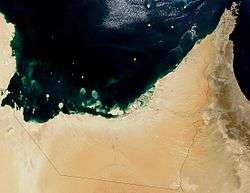 | |
| Continent | Asia |
|---|---|
| Region | Middle East |
| Coordinates | 24°N 54°E |
| Area | Ranked 114th |
| • Total | 83,600 km2 (32,300 sq mi) |
| • Land | 100% |
| • Water | 0% |
| Coastline | 1,318 km (819 mi) |
| Borders | total: 867 km (539 mi) |
| Highest point | Jebel Al Mebrah 1,727 m (5,666 ft)[1][2] |
| Lowest point | Persian Gulf 0 m |
| Longest river | None |
| Largest lake | Lake Zakher |
| Climate | arid; mild, pleasant winters; very hot, humid summers |
| Terrain | mountainous and barren desert covered with loose sand and gravel |
| Natural Resources | petroleum, natural gas, marine resources |
| Natural Hazards | haze, dust storms, sandstorms common |
| Environmental Issues | limited natural freshwater resources are increasing dependence on large-scale desalination facilities |
| Exclusive economic zone | 58,218 km2 (22,478 sq mi) |
| Part of a series on |
| Life in the United Arab Emirates |
|---|
 |
|
|
The land border with Qatar in the Khawr al Udayd area is a source of ongoing dispute (in fact, whether it even shares a land border with Qatar is in dispute). The total area of the UAE is approximately 83,600 square kilometres (32,300 square miles). The country's exact size is unknown because of disputed claims to several islands in the Persian Gulf, because of the lack of precise information on the size of many of these islands, and because most of its land boundaries, especially with Saudi Arabia, remain undemarcated. The largest emirate, Abu Dhabi, accounts for 87 percent of the UAE's total area (72,732 km2 (28,082 sq mi)). The smallest emirate, Ajman, encompasses only 259 km2 (100 sq mi).
Boundaries
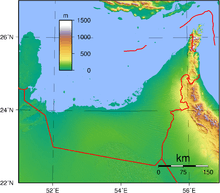
The UAE stretches for more than 650 km (400 mi) along the southern shore of the Persian Gulf. Most of the coast consists of salt pans that extend far inland. The largest natural harbor is at Dubai, although other ports have been dredged at Abu Dhabi, Sharjah, and elsewhere. Numerous islands are found in the Persian Gulf, and the ownership of some of them has been the subject of international disputes with both Iran and Qatar. The smaller islands, as well as many coral reefs and shifting sandbars, are a menace to navigation. Strong tides and occasional windstorms further complicate ship movements near the shore.
These northern emirates on the Persian Gulf and Gulf of Oman are part of the Gulf of Oman desert and semi-desert ecoregion.[3]
South and west of Abu Dhabi, vast, rolling sand dunes merge into the Rub' al Khali (Empty Quarter) of Saudi Arabia. The desert area of Abu Dhabi includes two important oases with adequate underground water for permanent settlements and cultivation. The extensive Liwa Oasis is in the south near the undefined border with Saudi Arabia, and about 100 km (62 mi) to the northeast is Al Buraymi Oasis, which extends on both sides of the Abu Dhabi-Oman border.[4][5][6][7][8][9][10]
Prior to withdrawing from the area in 1971, Britain delineated the internal borders among the seven emirates in order to preempt territorial disputes that might hamper formation of the federation. In general, the rulers of the emirates accepted the British intervention, but in the case of boundary disputes between Abu Dhabi and Dubai, and also between Dubai and Sharjah, conflicting claims were not resolved until after the UAE became independent. The most complicated borders were in the Western Mountains, where five of the emirates contested jurisdiction over more than a dozen enclaves.
 The coast of Abu Dhabi
The coast of Abu Dhabi An organised dune-bashing safari in the Emirate of Dubai
An organised dune-bashing safari in the Emirate of Dubai
Mountains
The UAE also extends for about 90 km (56 mi) along the Gulf of Oman, an area known as Al-Batinah coast. The Western Hajar Mountains[4] (Jibāl Al-Ḥajar Al-Gharbī), rising in places to 2,500 m (8,200 ft), separate Al-Batinah coast from the rest of the UAE. Beginning at the UAE-Oman border on the Persian Gulf coast of the Ras Musandam (Musandam Peninsula), the Western Mountains extend southeastward for about 150 km (93 mi) to the southernmost UAE-Oman frontier on the Gulf of Oman. The range continues as the Eastern Hajar Mountains (Jibāl Al-Ḥajar Ash-Sharqī) for more than 500 km (310 mi) into Oman. The steep mountain slopes run directly to the shore in many places. Nevertheless, there are small harbors at Dibba Al-Hisn, Kalba, and Khor Fakkan on the Gulf of Oman. In the vicinity of Fujairah, where the mountains do not approach the coast, there are sandy beaches.

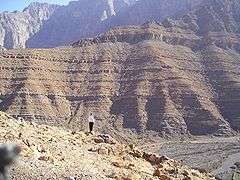 The mountainous region of Al Hajar Mountains near Hatta in northern UAE
The mountainous region of Al Hajar Mountains near Hatta in northern UAE
Climate
The climate of the UAE generally is very hot and sunny during the day but at night it becomes very cold. The hottest months are July and August, when average maximum temperatures reach above 50 °C (122.0 °F) on the coastal plain. In the Western Hajar Mountains, temperatures are considerably cooler, a result of increased altitude. Average minimum temperatures in January and February are between 10 and 14 °C (50.0 and 57.2 °F). During the late summer months, a humid southeastern wind known as the sharqi makes the coastal region especially unpleasant. The average annual rainfall in the coastal area is less than 120 mm (4.7 in), but in some mountainous areas annual rainfall often reaches 350 mm (13.8 in). Rain in the coastal region falls in short, torrential bursts during the summer months, sometimes resulting in floods in ordinarily dry wadi beds. The region is prone to occasional, violent dust storm, which can severely reduce visibility. The Jebel Jais mountain cluster in Ras Al Khaimah has experienced snow only four times (2004, 2009, 2017 and 2020 ) since records began.[11][12]
Flora and fauna
Date palms, as well as acacia and eucalyptus trees, are commonly found growing at the region's oases. Within the desert itself, the flora is much more sparse and primarily consists of grasses and thornbushes.
The region's indigenous fauna had previously come close to extinction due to intensive hunting, which led to a 1970s conservation program on the Bani Yas island by Sheikh Zayed bin Sultan Al Nahyan; this resulted in the survival of Arabian oryxes and leopards, among others. The region's coastal fish consist mainly of mackerel, perch and tuna, as well as sharks and whales.
 Acacia tortilis in Sharm-Dabna, Fujairah Emirate
Acacia tortilis in Sharm-Dabna, Fujairah Emirate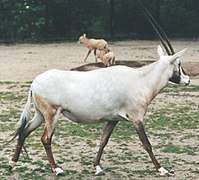
Area and land boundaries
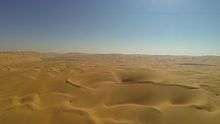
Area:
- Total: 83,600 km2 (32,300 sq mi)
- Land: 83,600 km2 (32,300 sq mi)
- Water: 0 km²
Land boundaries:
- Total: 867 km (539 mi)
- Border countries: Oman 410 km (250 mi); Saudi Arabia 457 km (284 mi)
Coastline: 1,318 km (819 mi)
Maritime claims:
- Contiguous zone: 24 nmi (27.6 mi; 44.4 km)
- Continental shelf: 200 nmi (230.2 mi; 370.4 km) or to the edge of the continental margin
- Exclusive economic zone: 58,218 km2 (22,478 sq mi) with 200 nmi (230.2 mi; 370.4 km)
- Territorial sea: 12 nmi (13.8 mi; 22.2 km)
Elevation extremes:
- Lowest point: Persian Gulf 0 m
- Highest point: Jebel Al Mebrah 1,727 m (5,666 ft)[lower-alpha 1]
Resources and land use
- Natural resources: petroleum, natural gas
- Land use:
- Arable land: 0.77%
- Permanent crops: 2.27%
- Other: 96.96% (2005)
- Irrigated land: 2,300 km2 (890 sq mi) (2003)
- Total renewable water resources: 0.2 km2
Environmental concerns
- Natural hazards: frequent sand and dust storms
- Environment - current issues: lack of natural freshwater resources being overcome by desalination plants; desertification; beach pollution from oil spills
- Environment - international agreements: party to:
- Biodiversity, Climate Change, Desertification, Endangered Species, Hazardous Wastes, Marine Dumping, Ozone Layer Protection
- Signed, but not ratified: Law of the Sea
See also
- List of United Arab Emirates-related topics
Notes
- Jebel Jais is the highest mountain in the UAE with a height of 1,934 m (6,345 ft), but because its peak is in Oman, Jebel Yibir or Mebrah has the highest peak[1][2]
References
- "Jabal Yibir". Dangerousroads.org. Retrieved 2019-02-12.
- "Geography of United Arab Emirates, Landforms - World Atlas". www.worldatlas.com. Retrieved 2017-03-27.
- "Gulf of Oman desert and semi-desert". Terrestrial Ecoregions. World Wildlife Fund.
- Lancaster, Fidelity; Lancaster, William (2011). Honour is in Contentment: Life Before Oil in Ras Al-Khaimah (UAE) and Some Neighbouring Regions. Berlin, New York: Walter de Gruyter. pp. 3–598. ISBN 3-1102-2339-2.
- Leech, Nick (2015-10-22). "The long read: has a lost Arab capital been found on the Oman-UAE border?". The National. Retrieved 2019-01-20.
- Al-Hosani, Hamad Ali (2012). The Political Thought of Zayed bin Sultan Al Nahyan (PhD Thesis) (Thesis). Durham University. pp. 43–44. Archived (PDF) from the original on 5 February 2017. Retrieved 15 April 2016.
- Morton, Michael Quentin (15 April 2016). Keepers of the Golden Shore: A History of the United Arab Emirates (1st ed.). London: Reaktion Books. ISBN 978-1-7802-3580-6. Retrieved 8 November 2016.
- Allen, Calvin H., Jr. (2016-02-05). "1: Land and People". Oman: the Modernization of the Sultanate. Abingdon, New York: Routledge. pp. 1–8. ISBN 1-3172-9164-6.
- El Reyes, Dr. Abdulla, ed. (December 2014). Liwa Journal of the National Archives (PDF). United Arab Emirates: Emirati National Archives. pp. 35–37. Retrieved 5 February 2017.
- Janet L. Abu-Lughod (contributor) (2007). "Buraimi and Al-Ain". In Dumper, Michael R. T.; Stanley, Bruce E. (eds.). Cities of the Middle East and North Africa: A Historical Encyclopedia. ABC-CLIO. pp. 99–100. ISBN 1-5760-7919-8.
- Nasouh Nazzal (2009-01-24). "Heavy snowfall on Ras Al Khaimah's Jebel Jais mountain cluster". Gulf News. Archived from the original on 2009-02-02. Retrieved 2009-01-31.
- "Watch: Snowfall in UAE, temperature hits -2.2 degree". Khaleej Times. 2017-02-04. Retrieved 2017-02-05.

